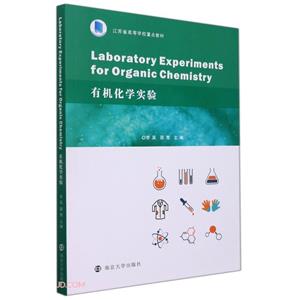包郵 有機(jī)化學(xué)實(shí)驗(yàn)
-
>
宇宙、量子和人類(lèi)心靈
-
>
氣候文明史
-
>
南極100天
-
>
考研數(shù)學(xué)專(zhuān)題練1200題
-
>
希格斯:“上帝粒子”的發(fā)明與發(fā)現(xiàn)
-
>
神農(nóng)架疊層石:10多億年前遠(yuǎn)古海洋微生物建造的大堡礁
-
>
聲音簡(jiǎn)史
有機(jī)化學(xué)實(shí)驗(yàn) 版權(quán)信息
- ISBN:9787305243585
- 條形碼:9787305243585 ; 978-7-305-24358-5
- 裝幀:一般膠版紙
- 冊(cè)數(shù):暫無(wú)
- 重量:暫無(wú)
- 所屬分類(lèi):>
有機(jī)化學(xué)實(shí)驗(yàn) 內(nèi)容簡(jiǎn)介
目前,許多本科高校不斷擴(kuò)大本科留學(xué)生的招生規(guī)模,與國(guó)外高等院校開(kāi)展中外合作辦學(xué)并開(kāi)設(shè)中外合作辦學(xué)專(zhuān)業(yè),同時(shí)部分高校理工科等專(zhuān)業(yè)也在嘗試開(kāi)設(shè)全英文化學(xué)專(zhuān)業(yè)類(lèi)課程。本書(shū)根據(jù)我國(guó)高校有機(jī)化學(xué)實(shí)驗(yàn)項(xiàng)目特點(diǎn),結(jié)合國(guó)外有機(jī)化學(xué)實(shí)驗(yàn)內(nèi)容,圍繞實(shí)驗(yàn)安全、正確操作實(shí)驗(yàn)相關(guān)技術(shù)、實(shí)驗(yàn)基本技能、波譜方法在有機(jī)化學(xué)實(shí)驗(yàn)中的應(yīng)用以及有機(jī)化學(xué)實(shí)驗(yàn)項(xiàng)目等內(nèi)容展開(kāi),其中本教材率先引入了英國(guó)《危險(xiǎn)健康控制》(ControlofSubstancesHazardoustoHealth(COSHH))系統(tǒng),詳細(xì)介紹了評(píng)估化學(xué)品安全性的方法,強(qiáng)調(diào)了實(shí)驗(yàn)安全的重要性;在正確操作實(shí)驗(yàn)相關(guān)技術(shù)部分,對(duì)有機(jī)化學(xué)實(shí)驗(yàn)中常用到的稱(chēng)量法、藥品轉(zhuǎn)移法、加熱冷卻法、玻璃儀器清洗法等均做了詳細(xì)介紹;在實(shí)驗(yàn)基本技能部分,對(duì)回流、過(guò)濾、熔沸點(diǎn)測(cè)定、重結(jié)晶、干燥、萃取、旋轉(zhuǎn)蒸發(fā)等重要有機(jī)合成操作技能進(jìn)行了詳細(xì)的講解,并對(duì)原理進(jìn)行了簡(jiǎn)介;波譜方法在有機(jī)化學(xué)實(shí)驗(yàn)中的應(yīng)用部分,對(duì)常用的四大波譜方法的機(jī)理和操作進(jìn)行了簡(jiǎn)單的介紹;實(shí)驗(yàn)部分,則包括了《環(huán)己烷的純化》等共35個(gè)有機(jī)化學(xué)實(shí)驗(yàn),其中《由Robinson關(guān)環(huán)反應(yīng)制備雙甲酮》等近8個(gè)實(shí)驗(yàn)引進(jìn)自雷丁大學(xué)有機(jī)化學(xué)實(shí)驗(yàn)項(xiàng)目,并進(jìn)行了相應(yīng)的改編。
有機(jī)化學(xué)實(shí)驗(yàn) 目錄
1.1 Safety in the Laboratory
1.2 Chemical Hazards
1.3 Use of a COSHH Form
1.4 Pre-lab Reports or Notebooks Used in the Laboratory
1.5 Lab Reports
1.6 Samples of Reports and COSHH Form
1.7 Commonly Used Laboratory Glassware
2 Carrying out an Experiment
2.1 Measurements in a Laboratory
2.2 Transferring Reagents
2.3 Heating and Cooling Methods
2.4 Setting up a Reaction
2.5 Methods for Glassware Cleaning
2.6 Literature Investigation for the Experiment
3 Basic Techniques in Organic Laboratory
3.1 Assembling Glassware
3.2 Refluxing
3.3 Simple Inert Gas Protection
3.4 Smelling a Chemical
3.5 Boiling Point and Distillation
3.6 Melting Points
3.7 Sublimation
3.8 Filtration
3.9 Recrystallization
3.10 Drying Organic Solvents
3.11 Drying Organic Solutions
3.12 Drying Solid Organic Compounds
3.13 Extraction
3.14 Rota-evaporation
3.15 Chromatography
3.15.1 Thin-Layer Chromatography
3.15.2 Flash Chromatography
3.15.3 High Performance Liquid Chromatography
3.15.4 Gas Chromatography
4 Application of Spectroscopy in Organic Laboratory
4. 1 Introduction
4. 2 Ultraviolet-Visible Spectroscopy
4. 3 Fourier Transform Infrared Spectroscopy
4. 4 Mass Spectrometry
4. 5 Nuclear Magnetic Resonance Spectroscopy
5 Organic Experiments
5.1 Purification of Liquids by Distillation
5.2 Purification of Organic Compounds by Extraction
5.3 Purification of Solids by Recrystallization
5.4 Purification of Cyclohexane
5.5 Preparation of Bromoethane
5.6 Synthesis of Ethyl Acetate
5.7 Synthesis of Benzoin
5.8 Synthesis of Cinnamic Acid by the Perkin Reaction
5.9 Synthesis of Cinnamic Acid by the Knoevenagel Condensation
5.10 Synthesis of Methyl Orange
5.11 Synthesis of Ethyl Benzoate
5.12 The Diels-Alder Reaction
5.13 Synthesis of Acetanilide
5.14 Bromination of Acetanilide
5.15 Deprotection of the Acetyl Protecting Group from p-Bromoacetanilide
5.16 Synthesis of Aspirin
5.17 Synthesis of Ferrocene via the Phase Transfer Catalysis
5.18 Synthesis of 2-Nitro-l,3-benzenediol
5.19 Preparation of the Urea-Formaldehyde Resin
5.20 Preparation of Cyclohexene
5.21 Synthesis of 2-Chloro-2-methylpropane
5.22 Synthesis of Dibutyl Ether
5.23 Synthesis of Butyl Phenyl Ether
5.24 Synthesis of Hexane-1,6-dionic Acid
5.25 Preparation of Furfuryl Alcohol and 2-Furoic Acid by the Cannizzaro Reaction
5.26 A Solvent Free Cannizzaro Reaction
5.27 Reduction of 3-Nitroacetophenone Using Sodium Borohydride
5.28 Reduction of 3-Nitroacetophenone Using Sn/HCl
5.29 Synthesis of 4-Vinylbenzoic Acid via the Wittig Reaction
5.30 Preparation of 1,5-Diphenylpenta-l,4-dien-3-one Using the Aldol Condensation
5.31 Preparation of 2-Methylbutan-2-ol via the Grignard Reagent
5.32 Preparation of Dimedone via the Robinson Annulation
5.33 Preparation of Phenacetin from p-Aminophenol via a Two-Step Synthesis
5.34 Extraction of Alkaloids from Chinese Herbs--Coptis Chinensis
5.35 Extraction of Caffeine from Teas
6 Appendices
6.1 List of Equipment and Glassware for Each Experiment
6.2 List of Chemicals for Each Experiment
6.3 Appendix Tables
6.4 Abbreviations
有機(jī)化學(xué)實(shí)驗(yàn) 作者簡(jiǎn)介
李英,博士,南京信息工程大學(xué)化學(xué)與材料學(xué)院教授,碩士生導(dǎo)師。主要研究方向:以多肽為代表的水凝膠類(lèi)軟物質(zhì)材料的設(shè)計(jì)、制備及應(yīng)用展開(kāi),以獲得機(jī)械性能增強(qiáng)、穩(wěn)定性較高的多肽水凝膠材料,并研究其在體內(nèi)及體外的生物應(yīng)用。承擔(dān)本科生“有機(jī)化學(xué)”“FurtherOrganicChemistry”等課程。 邵鶯,博士,常州大學(xué)石油與化工學(xué)院教授。
- >
苦雨齋序跋文-周作人自編集
- >
二體千字文
- >
莉莉和章魚(yú)
- >
姑媽的寶刀
- >
山海經(jīng)
- >
史學(xué)評(píng)論
- >
隨園食單
- >
有舍有得是人生

















